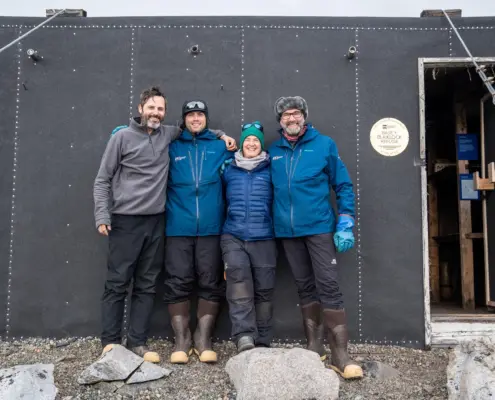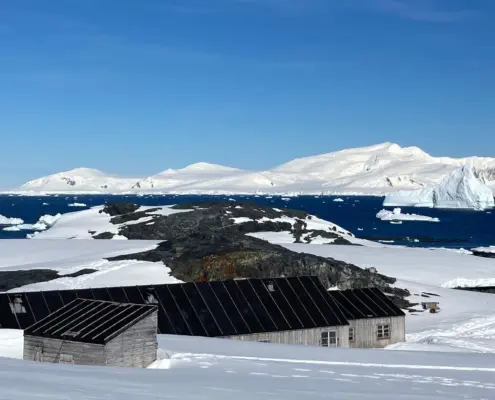In partnership with sister organisation, UK Antarctic Heritage Trust (UKAHT), our team has carried out a 14-week conservation programme at the historic bases on Stonington Island, off the Antarctic Peninsula.
This initiative was another step towards conserving the huts in a remote and remarkable region and is part of an ongoing partnership with UKAHT, announced in 2017, to support an extensive conservation programme of Britain’s heritage across multiple sites on the Antarctic Peninsula.
The Trust is delighted to share with UKAHT its extensive knowledge around cold-climate conservation. The Trust’s experience conserving the early explorer bases at Ross Island involved staff developing innovative and detailed methodologies for treating artefacts in the world’s most extreme environment.
From 1940–1974 Stonington Island was the site of operations for both the Americans and British, where they carried out significant survey work in the Peninsula region. During the season, the Trust’s Programme Manager, Al Fastier and the team completed a detailed conservation survey of the historic British scientific base hut, known as Base E, which was established in 1946. Partway through the season, Al departed and the Trust’s Programme Manager – Artefacts, Lizzie Meek joined the team.
The logistics to reach Stonington Island are challenging, and rely on the goodwill and strong relationships UKAHT has built up with the IAATO tour ship companies and British Royal Navy. It takes a week to travel there from either South America or the Falkland Islands, with landing reliant on good sea ice conditions at the time. Fortunately the conservation team was able to land safely, along with equipment and supplies for the intensive 14 weeks of surveying, artefact cataloguing and emergency repair work.
Their survey revealed the bulk of items to be conserved at Stonington are food tins and parts relating to the Lister generator set, which provided electricity for the base.
Conditions on the island were warmer, wetter and saltier than Ross Island, making it challenging for the preservation of artefacts. The buildings were often drenched in salt spray, hurled horizontally across the island by the infamous ‘Fumigator’ katabatic wind, which whirls down from the glacier at the top of the peninsula at speeds of up to 150kph. Although there were a number of similarities to working at the Ross Island huts, such as sleeping in tents, limited food, cold toes, snow and rusty tins, they reported some noticeable differences, including the diversity of wildlife, higher tourist numbers, and more modern building materials.
With its wild weather, rich wildlife and breathtaking views, the 750m long island remains a stunning and unique historic site. It has a constantly calving glacier in the adjacent bay, and shingle beaches occupied by Weddell, fur, crab-eater and leopard seals. Nesting Antarctic terns are constant, noisy companions, and later in the season a small collection of moulting Adélie penguins shelter among the rocky outcrops.
This project is part of the developing relationship between the two trusts, and follows on from a previous initiative in February 2017, when Al assisted the UKAHT to complete a building survey of Hut Y, at Horseshoe Island on the Antarctic Peninsula. The team look forward to continuing this work with UKAHT next season.




